Karel Lamač (1897-1952), aka Karl Lamac, Carl Lamac, and Carl Lamač, was a Czech actor and filmmaker who directed more than 100 films in Czechoslovakia, Germany, France, Austria, the Netherlands, and Great Britain. He was famous for the many comedies he directed with Czech actress Anny Ondra. Till 17 September 2020, CineGraph, the Národní Filmový Archiv (NFA) in Prague, and the Metropolis-Kino in Hamburg organise a retrospective of Lamac's films: Karel Lamač: Film-Europäer zwischen Prag und Hamburg.

Czech postcard, no. 53. Photo: Willy Ströminger, Praha. Anny Ondra and Karel Lamac in an unidentified film.
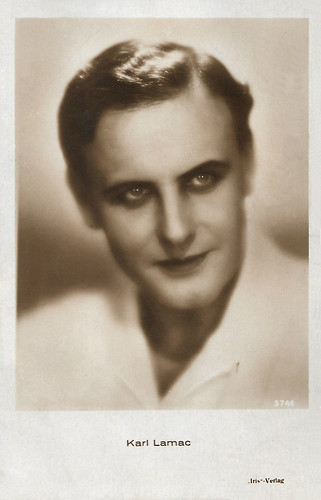
Austrian postcard by Iris Verlag, no. 5746. Photo: Balzar, Praha (Prague).

German postcard by Ross Verlag, no. 2072/1, 1927-1928. Photo: Balzar, Praha (Prague).

Austrian postcard by Iris-Verlag, no. 5334. Photo: Lux-Film Verleih. Karel Lamač and Anny Ondra in Kvet ze Sumavy/A Flower of the Sumava Mountains (Karel Lamac, 1927).
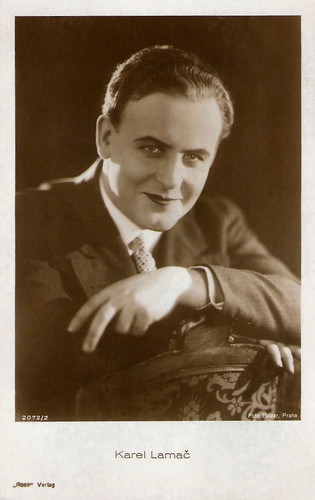
German postcard by Ross Verlag, no. 2072/2, 1927-1928. Photo: Balzar, Praha (Prague).
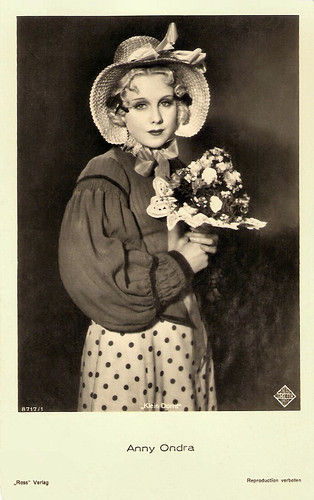
German postcard by Ross Verlag, no. 8717, 1933-1934. Photo: Ondra-Lamac-Film. Anny Ondra in Klein Dorrit/Little Dorrit (Carl Lamac, 1934).
Karel Lamač was born in 1897 in Prague, Austria-Hungary (now Czech Republic). His parents were Karel Lamač Sr., an opera singer, and a pharmacist, and Františka Lamačová (née Prusíková). In his childhood, Lamač was interested in pharmacy, electrical engineering, stage magic, and acting. Before WWI he went to Dresden to become an apprentice at the camera manufacturing company of Ernemann.
During the war, he was a combat cameraman. After the war, he became a technical director at the film laboratory of Excelsiorfilm. He started working in films in 1918, first as an actor, later as a writer and a director. In the Czech film Akord smrti (1919), he had his debut as (co-)director with Jan Stanislav Kolár. In 1920, he first co-acted with comedian actress Anna Ondráková (Anny Ondra) in Gilly poprvé v Praze/Gilly zum ersten Mal in Prag (1920).
Since then, he acted together with her in almost all of his films, and for a long time, they were married too (though some sources doubt this). In 1921 both founded the Kalos film company in Czechoslovakia, wherein in 1924 cameraman Otto Heller and in 1925 screenwriter Václav Wasserman joined them. This team was soon known as "the Strong Four".
Among his best films of the Czech silent era are the crime drama Otrávené světlo/The Poisoned Light (Jan S. Kolár, Karel Lamač, 1921), the comedy Chyťte ho!/ Catch Him! (Karel Lamač, 1925) and the drama Bílý ráj/White Paradise (Karel Lamač, 1924). From 1925 he directed films at the Kavalírka studio for the company Bratři Deglové. In 1928 Lamač had huge success as a performer under the direction of Martin Frič in Páter Vojtěch. From 1924 Lamac also had a parallel career as an actor in the German cinema, first as Patroclus opposite Carlo Aldini as Achilles in the epic Helena (Manfred Noa, 1924).
In 1928 he moved to Germany for his film direction too, working for Hom-Film. He directed Anny Ondra as the star of comedy films such as Der erste Kuß/The First Kiss (1928), Saxophon-Susi/Suzy Saxophone (1928), and Das Mädel mit der Peitsche/The Girl with the Whip (1929), while he refrained from acting henceforth. In the late 1920s, he still worked in Prague too at times, e.g. Hříchy lásky/Sin of a Beautiful Woman (1929) with Marcella Albani, but this part of his career stopped when the Kavalirka studio burned down in 1929.

German postcard by Ross Verlag, no. 4250/1, 1929-1930.

French postcard by CE (Editions Cinémagazine), no. 703. Photo: Sofar. Werner Fuetterer in Das Mädel mit der Peitsche/The Girl with the Whip (Carl Lamac, 1929), starring Anny Ondra. The film was released by Sofar in France as Vive l'amour.

French postcard by Cinémagazine-Edition, Paris, no. 707. Photo: Sofar. Anny Ondra in Sündig und süß/Sinful and Sweet (Carl Lamac, 1929), released in France as Anny de Montparnasse.

German postcard by Ross Verlag, no. 4774/2, 1929-1930. Photo: Hom Film. Anny Ondra in Sündig und süss/Sinful and Sweet (Carl Lamac, 1929).

German postcard by Ross Verlag, no. 5495/1, 1930-1931. Photo: Süd-Film. Harry Frank and Fee Malten in Der falsche Feldmarschall/The Fake Field Marshal (Carl Lamac, 1930).
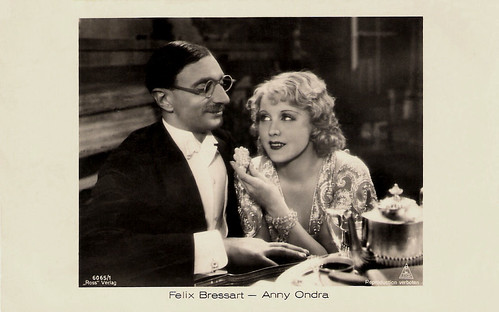
German postcard by Ross Verlag, no. 6065/1, 1931-1932. Photo: Ondra Lamac Film. Felix Bressart and Anny Ondra in Eine Freundin so goldig wie Du/A cute girlfriend like you (Carl Lamac, 1930).
In 1929 Karel Lamač founded the production company Ondra-Lamač Film with Anny Ondra in Berlin. Their first joint film, Die vom Rummelplatz/Fairground People (1929), was a success and made up for Ondra's failed career in Britain, where her voice in Hitchcock's sound version of Blackmail (Alfred Hitchcock, 1929) was dubbed by the British actress Joan Barry. During the 1930s Lamač was making films in Germany, Czechoslovakia, France, and Austria - some were multiple language versions such as Kiki (1932), shot in French and German, but with Ondra in both versions.
While Ondra was not in every film by Lamac anymore by the mid-1930s after she had married boxer Max Schmeling, Lamac still directed her in several films after 1933 and even had Ondra and Schmeling act together in his film Knockout (Carl Lamac, 1935). Ondra and Lamač remarkably worked together for the last time in a film called Der Scheidungsgrund/Cause for Divorce (Carl Lamac, 1937).
Instead, Lamač did various films with Czech actor Vlasta Burian in the mid-1930s. With the rise of the National Socialists, it became more and more difficult for Lamac to work in Germany. His last German film was Frühlingsluft/Spring Air (Carl Lamac, 1938). After that began an odyssey through half of Europe. After the Nazi occupation of Czechoslovakia, Lamač first left for France where he shot Place de la Concorde (Carl Lamac, 1939) with Albert Préjean, and Dolly Mollinger. In the Netherlands, he made De spooktrein/The Ghost Train (1939), an adaptation of the British play 'The Ghost Train' by Arnold Ridley.
He then moved to the United Kingdom where he joined the Czechoslovak Army. He served in the RAF until 1941 and in an infantry division until 1946. He made war documentaries and three feature films during WWII, including Schweik's New Adventures/It Started at Midnight (1943), based on the popular novel by Jaroslav Hašek. In 1926 Lamac had already filmed Hašek's original novel 'The Good Soldier Schwejk'.
After the war, he made two films in France. In 1947 he went to the USA where he worked on technical innovations of colour film and camera lenses. In 1951 he returned to Germany and directed his last film Die Diebin von Bagdad/The Thief of Bagdad (Carl Lamac, 1952) with Sonja Ziemann. In 1952, Karel Lamač died in Hamburg, West Germany due to serious problems with his kidneys and liver. He was 55.

Dutch postcard. Photo: City Film. Hermann Thimig and Anny Ondra in Kiki (Carl Lamac, 1932).

Dutch postcard by JosPe, no. 287. Photo: Remaco. Ralph Arthur Roberts and Anny Ondra in Eine Nacht im Paradies/One Night in Paradise (Carl Lamac, 1932).

Dutch postcard by City Film, no. 492. Photo: Anny Ondra and Ida Wüst in Fräulein Hoffmanns Erzählungen/The Tales of Ms. Hoffmann (Carl Lamac, 1933).
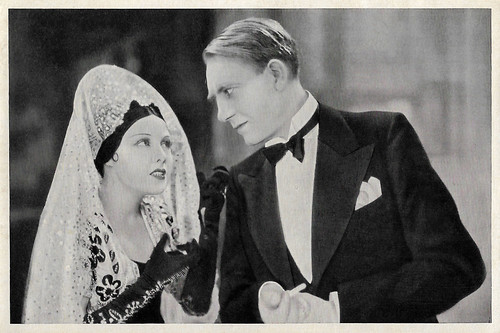
German collectors card in the series 'Vom Werden deutscher Filmkunst - Der Tonfilm', album no. 11, picture no. 55, group 44. Photo: Ondra-Lamac-Film / Ross Verlag. Anny Ondra and Mathias Wieman in Fraulein Hoffmanns Erzählungen/The Tales of Ms. Hoffmann (Carl Lamac, 1933).
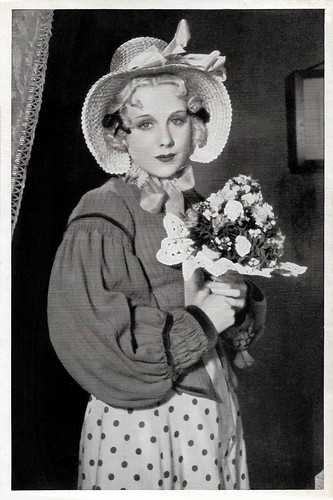
German collectors card in the series 'Vom Werden deutscher Filmkunst - Der Tonfilm', album no. 11, picture no. 56. Photo: Ondra-Lamac-Film / Ross Verlag. Anny Ondra in Klein Dorrit/Little Dorrit (Carl Lamac, 1934).

Dutch postcard by Filma, no. 620. Photo: Anny Ondra in Polenblut/Polish Blood (Carl Lamac, 1934). Collection: Geoffrey Donaldson Institute.
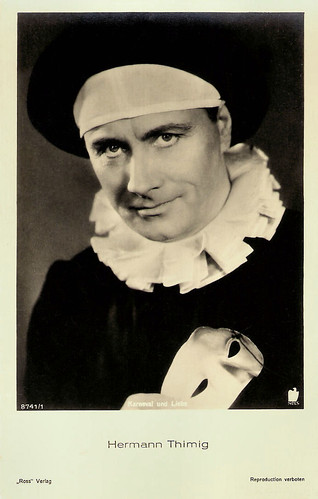
German postcard by Ross Verlag, no. 8741/1, 1933-1934. Photo: NDLS. Hermann Thimig in Karneval und Liebe/Carnival of Love (Carl Lamac, 1934).
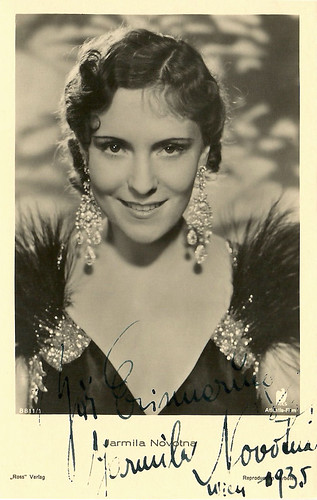
German postcard by Ross Verlag, no. 8811/1, 1933-1934. Photo: Atlantis-Film. Jarmila Novotná in Frasquita (Carl Lamac, 1934). Collection: Didier Hanson.
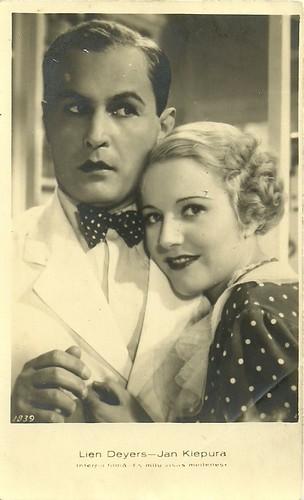
Latvian postcard by Ira, Riga, no. 1839. Jan Kiepura and Lien Deyers in Ich liebe alle Frauen/I Love All Women (Carl Lamac 1935).
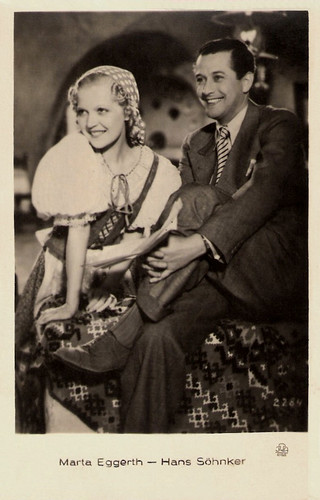
Latvian postcard, no. 2284. Photo: J. Rolin (?), Riga. Mártha (or Marta) Eggerth and Hans Söhnker in Wo die Lerche singt/Where the lark sings (Carl Lamac, 1936).

German postcard by Ross Verlag, no. A 1379/1, 1937-1938. Photo: Donau-Film. Geraldine Katt in Florentine (Carl Lamac, 1937).
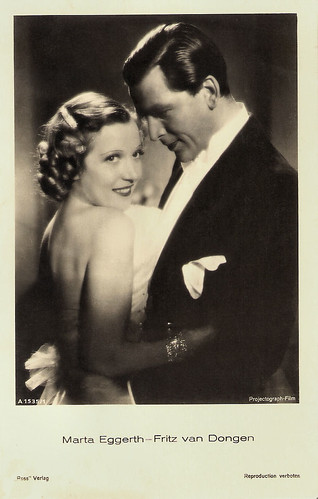
German postcard by Ross Verlag, no. A 1535/1, 1937-1938. Photo: Projectograph-Film. Marta Eggerth and Frits van Dongen in Immer wenn ich glücklich bin..!/Waltz Melodies (Karel Lamac, 1938).

German postcard by Kunst und Bild, Berlin. Photo: Pontus Film.
Sonja Ziemann in Die Diebin von Bagdad/The Thief of Baghdad (Carl Lamac, 1952).
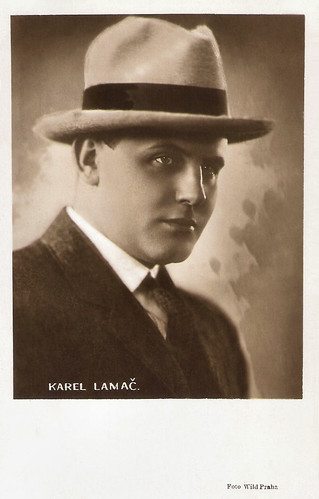
Czech postcard by Náki, M. Brandové, Praha. Photo: Wild, Praha (Prague).
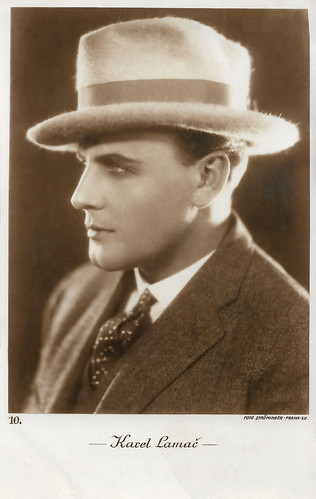
Czech postcard, no. 10. Photo: Willy Ströminger, Praha (Prague).
Sources: Wikipedia (English and German), and IMDb. And special thanks to Jean Ritsema.
This post was last updated on 27 January 2024.

Czech postcard, no. 53. Photo: Willy Ströminger, Praha. Anny Ondra and Karel Lamac in an unidentified film.

Austrian postcard by Iris Verlag, no. 5746. Photo: Balzar, Praha (Prague).

German postcard by Ross Verlag, no. 2072/1, 1927-1928. Photo: Balzar, Praha (Prague).

Austrian postcard by Iris-Verlag, no. 5334. Photo: Lux-Film Verleih. Karel Lamač and Anny Ondra in Kvet ze Sumavy/A Flower of the Sumava Mountains (Karel Lamac, 1927).

German postcard by Ross Verlag, no. 2072/2, 1927-1928. Photo: Balzar, Praha (Prague).

German postcard by Ross Verlag, no. 8717, 1933-1934. Photo: Ondra-Lamac-Film. Anny Ondra in Klein Dorrit/Little Dorrit (Carl Lamac, 1934).
The Strong Four
Karel Lamač was born in 1897 in Prague, Austria-Hungary (now Czech Republic). His parents were Karel Lamač Sr., an opera singer, and a pharmacist, and Františka Lamačová (née Prusíková). In his childhood, Lamač was interested in pharmacy, electrical engineering, stage magic, and acting. Before WWI he went to Dresden to become an apprentice at the camera manufacturing company of Ernemann.
During the war, he was a combat cameraman. After the war, he became a technical director at the film laboratory of Excelsiorfilm. He started working in films in 1918, first as an actor, later as a writer and a director. In the Czech film Akord smrti (1919), he had his debut as (co-)director with Jan Stanislav Kolár. In 1920, he first co-acted with comedian actress Anna Ondráková (Anny Ondra) in Gilly poprvé v Praze/Gilly zum ersten Mal in Prag (1920).
Since then, he acted together with her in almost all of his films, and for a long time, they were married too (though some sources doubt this). In 1921 both founded the Kalos film company in Czechoslovakia, wherein in 1924 cameraman Otto Heller and in 1925 screenwriter Václav Wasserman joined them. This team was soon known as "the Strong Four".
Among his best films of the Czech silent era are the crime drama Otrávené světlo/The Poisoned Light (Jan S. Kolár, Karel Lamač, 1921), the comedy Chyťte ho!/ Catch Him! (Karel Lamač, 1925) and the drama Bílý ráj/White Paradise (Karel Lamač, 1924). From 1925 he directed films at the Kavalírka studio for the company Bratři Deglové. In 1928 Lamač had huge success as a performer under the direction of Martin Frič in Páter Vojtěch. From 1924 Lamac also had a parallel career as an actor in the German cinema, first as Patroclus opposite Carlo Aldini as Achilles in the epic Helena (Manfred Noa, 1924).
In 1928 he moved to Germany for his film direction too, working for Hom-Film. He directed Anny Ondra as the star of comedy films such as Der erste Kuß/The First Kiss (1928), Saxophon-Susi/Suzy Saxophone (1928), and Das Mädel mit der Peitsche/The Girl with the Whip (1929), while he refrained from acting henceforth. In the late 1920s, he still worked in Prague too at times, e.g. Hříchy lásky/Sin of a Beautiful Woman (1929) with Marcella Albani, but this part of his career stopped when the Kavalirka studio burned down in 1929.

German postcard by Ross Verlag, no. 4250/1, 1929-1930.

French postcard by CE (Editions Cinémagazine), no. 703. Photo: Sofar. Werner Fuetterer in Das Mädel mit der Peitsche/The Girl with the Whip (Carl Lamac, 1929), starring Anny Ondra. The film was released by Sofar in France as Vive l'amour.

French postcard by Cinémagazine-Edition, Paris, no. 707. Photo: Sofar. Anny Ondra in Sündig und süß/Sinful and Sweet (Carl Lamac, 1929), released in France as Anny de Montparnasse.

German postcard by Ross Verlag, no. 4774/2, 1929-1930. Photo: Hom Film. Anny Ondra in Sündig und süss/Sinful and Sweet (Carl Lamac, 1929).

German postcard by Ross Verlag, no. 5495/1, 1930-1931. Photo: Süd-Film. Harry Frank and Fee Malten in Der falsche Feldmarschall/The Fake Field Marshal (Carl Lamac, 1930).

German postcard by Ross Verlag, no. 6065/1, 1931-1932. Photo: Ondra Lamac Film. Felix Bressart and Anny Ondra in Eine Freundin so goldig wie Du/A cute girlfriend like you (Carl Lamac, 1930).
Cause for Divorce
In 1929 Karel Lamač founded the production company Ondra-Lamač Film with Anny Ondra in Berlin. Their first joint film, Die vom Rummelplatz/Fairground People (1929), was a success and made up for Ondra's failed career in Britain, where her voice in Hitchcock's sound version of Blackmail (Alfred Hitchcock, 1929) was dubbed by the British actress Joan Barry. During the 1930s Lamač was making films in Germany, Czechoslovakia, France, and Austria - some were multiple language versions such as Kiki (1932), shot in French and German, but with Ondra in both versions.
While Ondra was not in every film by Lamac anymore by the mid-1930s after she had married boxer Max Schmeling, Lamac still directed her in several films after 1933 and even had Ondra and Schmeling act together in his film Knockout (Carl Lamac, 1935). Ondra and Lamač remarkably worked together for the last time in a film called Der Scheidungsgrund/Cause for Divorce (Carl Lamac, 1937).
Instead, Lamač did various films with Czech actor Vlasta Burian in the mid-1930s. With the rise of the National Socialists, it became more and more difficult for Lamac to work in Germany. His last German film was Frühlingsluft/Spring Air (Carl Lamac, 1938). After that began an odyssey through half of Europe. After the Nazi occupation of Czechoslovakia, Lamač first left for France where he shot Place de la Concorde (Carl Lamac, 1939) with Albert Préjean, and Dolly Mollinger. In the Netherlands, he made De spooktrein/The Ghost Train (1939), an adaptation of the British play 'The Ghost Train' by Arnold Ridley.
He then moved to the United Kingdom where he joined the Czechoslovak Army. He served in the RAF until 1941 and in an infantry division until 1946. He made war documentaries and three feature films during WWII, including Schweik's New Adventures/It Started at Midnight (1943), based on the popular novel by Jaroslav Hašek. In 1926 Lamac had already filmed Hašek's original novel 'The Good Soldier Schwejk'.
After the war, he made two films in France. In 1947 he went to the USA where he worked on technical innovations of colour film and camera lenses. In 1951 he returned to Germany and directed his last film Die Diebin von Bagdad/The Thief of Bagdad (Carl Lamac, 1952) with Sonja Ziemann. In 1952, Karel Lamač died in Hamburg, West Germany due to serious problems with his kidneys and liver. He was 55.

Dutch postcard. Photo: City Film. Hermann Thimig and Anny Ondra in Kiki (Carl Lamac, 1932).

Dutch postcard by JosPe, no. 287. Photo: Remaco. Ralph Arthur Roberts and Anny Ondra in Eine Nacht im Paradies/One Night in Paradise (Carl Lamac, 1932).

Dutch postcard by City Film, no. 492. Photo: Anny Ondra and Ida Wüst in Fräulein Hoffmanns Erzählungen/The Tales of Ms. Hoffmann (Carl Lamac, 1933).

German collectors card in the series 'Vom Werden deutscher Filmkunst - Der Tonfilm', album no. 11, picture no. 55, group 44. Photo: Ondra-Lamac-Film / Ross Verlag. Anny Ondra and Mathias Wieman in Fraulein Hoffmanns Erzählungen/The Tales of Ms. Hoffmann (Carl Lamac, 1933).

German collectors card in the series 'Vom Werden deutscher Filmkunst - Der Tonfilm', album no. 11, picture no. 56. Photo: Ondra-Lamac-Film / Ross Verlag. Anny Ondra in Klein Dorrit/Little Dorrit (Carl Lamac, 1934).

Dutch postcard by Filma, no. 620. Photo: Anny Ondra in Polenblut/Polish Blood (Carl Lamac, 1934). Collection: Geoffrey Donaldson Institute.

German postcard by Ross Verlag, no. 8741/1, 1933-1934. Photo: NDLS. Hermann Thimig in Karneval und Liebe/Carnival of Love (Carl Lamac, 1934).

German postcard by Ross Verlag, no. 8811/1, 1933-1934. Photo: Atlantis-Film. Jarmila Novotná in Frasquita (Carl Lamac, 1934). Collection: Didier Hanson.

Latvian postcard by Ira, Riga, no. 1839. Jan Kiepura and Lien Deyers in Ich liebe alle Frauen/I Love All Women (Carl Lamac 1935).

Latvian postcard, no. 2284. Photo: J. Rolin (?), Riga. Mártha (or Marta) Eggerth and Hans Söhnker in Wo die Lerche singt/Where the lark sings (Carl Lamac, 1936).

German postcard by Ross Verlag, no. A 1379/1, 1937-1938. Photo: Donau-Film. Geraldine Katt in Florentine (Carl Lamac, 1937).

German postcard by Ross Verlag, no. A 1535/1, 1937-1938. Photo: Projectograph-Film. Marta Eggerth and Frits van Dongen in Immer wenn ich glücklich bin..!/Waltz Melodies (Karel Lamac, 1938).

German postcard by Kunst und Bild, Berlin. Photo: Pontus Film.
Sonja Ziemann in Die Diebin von Bagdad/The Thief of Baghdad (Carl Lamac, 1952).

Czech postcard by Náki, M. Brandové, Praha. Photo: Wild, Praha (Prague).

Czech postcard, no. 10. Photo: Willy Ströminger, Praha (Prague).
Sources: Wikipedia (English and German), and IMDb. And special thanks to Jean Ritsema.
This post was last updated on 27 January 2024.
No comments:
Post a Comment